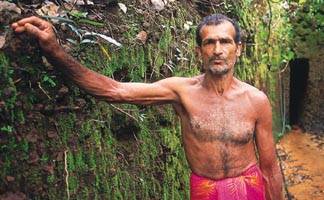| Kunhikannan Nair’s gait is easefully
languid, verging on sloth. There is an unmistakable economy of movement. But his hands are
different. Varicose veins wrap around supple muscles. Symbols of endless toil and latent
power. He looks very young for his 55 years. Just like the man who will carve out a surangam,
a 300-metre-deep tunnel in rock, which collects rainwater from the ghats. Nair’s
fields in Village Kodom Vellur of district Kasargod, Kerala, are a thick green,
characteristic of God’s own country, as the state is called. There is coconut, areca
nut, rubber, pepper and a little paddy. Although plantations have mushroomed in this
northern part of Kerala, there is not a lot of money to make in the fields.
Nair recalls the sleepless nights he used to spend thinking about water for his fields.
Kerala is one of the wettest states in India. But the slope of the Western Ghats
makes it difficult to store the water from the heavy rains during the monsoon.
The region’s answer to the problem is the surangam, a two-feet wide tunnel
that is about as high as an average person. It collects rainwater from the hilly catchment
above. A study by the Centre for Water Resources Development and Management (CWRDM),
Kozhikode, found some 570 surangams in district Kasaragod. "I always wanted to
make one. But it requires money. I did not have it earlier. Besides, I had too many other
things on my hands," says Nair, dressed in a red lungi rolled up to his knees.
At age 53, he arranged for a loan of Rs 5,000 from a cooperative bank to make his first
surangam. Making a surangam means as much hard work as money. It is only
about two-feet-wide and only high enough for a person to barely stand. For 45 days, Nair
hammered and chiselled at the hard weathered laterite of the ghats to carve out his surangam.
He had to hire labourers as well. He will get it extended to catch more rainwater when he
has the money.
The surangam means no more sleepless nights for Nair. He has assured water
supply for paddy. He now saves the money spent on hiring a pump-set. The yield of coconut
has risen. There is enough water for daily needs in the house. Enough to spare. Throughout
the year. This is the striking aspect of Nair’s surangam: it has water round
the year. As surangams go, this is not very common.
The surangam is a curious structure, as much in terms of engineering as history.
It is quite similar to the qanat of western Asia, which were popular in Syria,
Iraq, Iran and Palestine in 700 bc. Researchers have not been able to establish any link
between the surangam and the qanat. But it is widely believed that
Kerala’s structure came from western Asia.
The technology of making a surangam is quite intricate. Nair, a man of few
words, struggles to explain it. His knowledge of the terrain and behaviour of water has
not come from a formal school. It is a result of toiling on the fields. But Nair knows
that there is water where there are pala trees (trees with white milky sap). He
also knows that water is limited where there are rubber trees.
After deciding on the catchment, the hammering begins. By instinct, Nair knows the
gradation of digging. The CWRDM has studied the digging of a surangam. There
researchers will tell you that it is most appropriate right above the layer of granite,
which does not allow water to seep in. The weathered laterite rock overhead, on the other,
gives passage to water. Nair knows all this without ever attending school. Like so many
other farmers in the region, his calculations are solid. The failure rate of surangams
is only 10 per cent in northern Malabar.
Sitting in the neat and simple brick structure that is his house, Nair says the
government should provide more loans for making surangams. He does not want much
more.
He is capable of doing the rest himself. |






